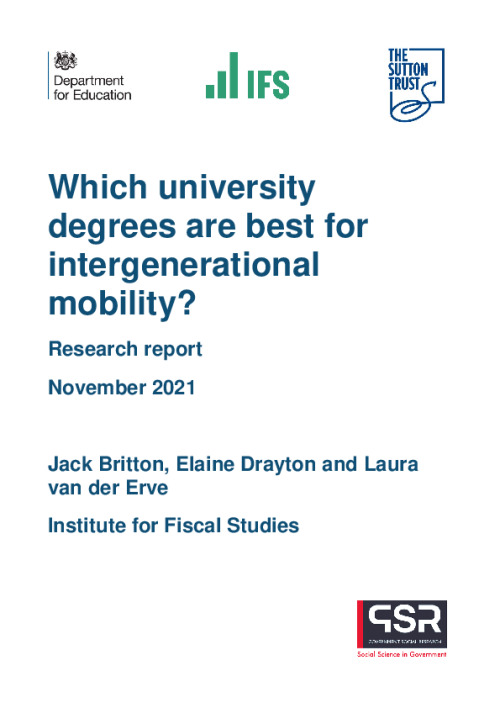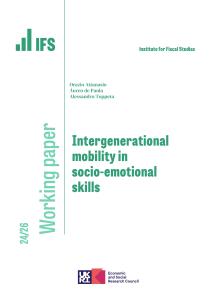Higher education is often seen as a crucial vehicle for improving intergenerational mobility. Previous research in the UK has generally looked in isolation at access to, or outcomes from, university for students coming from low-income backgrounds. Here, we put these components together to investigate the extent to which individual universities, subjects and courses (the term we use for specific subjects at specific universities, e.g. mathematics at the University of Warwick) promote intergenerational mobility.
In this report, we use the Longitudinal Education Outcomes (LEO) dataset to document mobility rates for each university, subject and course in England. Mobility rates are calculated via the following simple relationship:
Mobility rate = Access rate * Success rate
where the access rate is the share of students for each university, subject or course who are from low-income backgrounds, which we proxy using free school meal (FSM) eligibility, and the success rate is the share of those FSM students who make it to the top 20% of the earnings distribution at age 30. Because this latter measure requires people to have already turned 30, we focus our main analysis on people who attended university in the mid 2000s, although we also investigate the likely trends in mobility rates for more recent cohorts. Our key findings are as follows:
- Gaps in access are hugely variable depending on university selectivity. While low-income students are as likely to attend the least selective institutions as their wealthier peers, they are far less likely to attend the top universities: in the mid 2000s, students who attended private secondary schools were around 100 times more likely to attend Oxford or Cambridge than FSM-eligible students.
- There is also a lot of variation in access to different subjects. Pharmacology and social care have only very small gaps in access by socio-economic background, but there are large gaps in subjects such as medicine. In the mid 2000s, the privately educated were nearly 25 times more likely to study medicine than FSM-eligible students.
- The very best-performing institutions in terms of their labour market success admitted few FSM students. Similarly, the universities with the highest FSM access rates have below average success rates. However, across all universities, the correlation between access and success of -0.24 is relatively weak. Some universities do reasonably well on both metrics.
- The average mobility rate across all universities is 1.3%. This figure is well below our benchmark rate of 4.4%, the rate you would get if there were equal access to university for all income groups and undergraduates from all income backgrounds had the same chance of making it into the top 20%. This means that at age 30, only 1.3 in every 100 university graduates are in the top 20% of the earnings distribution and from a low-income background, compared with a benchmark of 4.4.
- There is considerable variation around this average mobility rate. The highest-mobility institutions are often less selective and based in big cities, with London institutions especially dominant. However, only seven institutions reach or improve upon our benchmark mobility rate of 4.4%.
- The high share of FSM pupils in London, many of whom perform well at school and are from ethnic minority backgrounds, is likely to explain at least part of the high access rates of London institutions.
- Many Russell Group universities have high success rates but admit very few FSM students, leading to below-average mobility rates. Queen Mary University of London (QMUL) is a remarkable exception, performing extremely well on both metrics and topping the overall mobility rankings with a mobility rate of 6.8%.
- Adjusting earnings for cost of living differences across the country improves the mobility rates of Northern universities, and lowers those in London and the South East. It does not change the overall ranking of universities very much, however. London universities still dominate the top of the mobility distribution, and the most selective universities still perform poorly.
- We also look at the impact of adjusting for student composition, such as in terms of prior attainment. Adjusting for differences in attainment and other characteristics of FSM students across universities only reinforces the message that many low-return, low-selectivity degrees do very well in terms of mobility. The least selective institutions move up the mobility ranking, while the most selective ones move even further down. However, the overall changes from this adjustment are relatively minor.
- Law, computing and (especially) pharmacology are the best-performing subject areas, with mobility rates of 2.2%, 2.9% and 4.2%, respectively. Around 10% of their students were FSM eligible and many of them perform well in terms of labour market success.
- There are, of course, alternative ways to define mobility rates, and our estimates here are not definitive. However, our overall conclusions are robust to reasonable changes to definitions (such as how we define low-income children and how we define success).
- While some courses have no students from low-income backgrounds, others have mobility rates that exceed 10%. Computing, law and economics at London-based institutions dominate the top 20 courses when ranked on mobility rates. Arts and humanities courses generally do poorly.
- There is much variation in mobility rates within institutions - many universities are in the top 10% of the mobility rankings for some subjects and in the bottom 10% for others. There is also substantial variation within subjects, across institutions. Even for the arts courses, which do poorly overall, there are some institutions with very good mobility rates.
- There is no correlation between the estimated returns and mobility rates at the university level, and only a small positive correlation at the course level. Many courses that do poorly in terms of boosting earnings on average do a lot to promote mobility.
- There has been a slow but steady increase in the access rates of FSM students in the decade since our oldest cohorts entered university in the mid 2000s. This period encompasses the large higher education reforms that occurred in 2012. However, at many universities, progress over this period was negligible.
- Based on these improved access rates, we predict an increase in average mobility rates from 1.3% for cohorts at university during the mid 2000s to around 1.6% for cohorts entering university in 2018 and 2019. Thus, the improvements in access still leave us well below our benchmark mobility rate of 4.4%. There is clearly much progress still to be made, especially by the most selective universities, where access rates remain extremely low.












